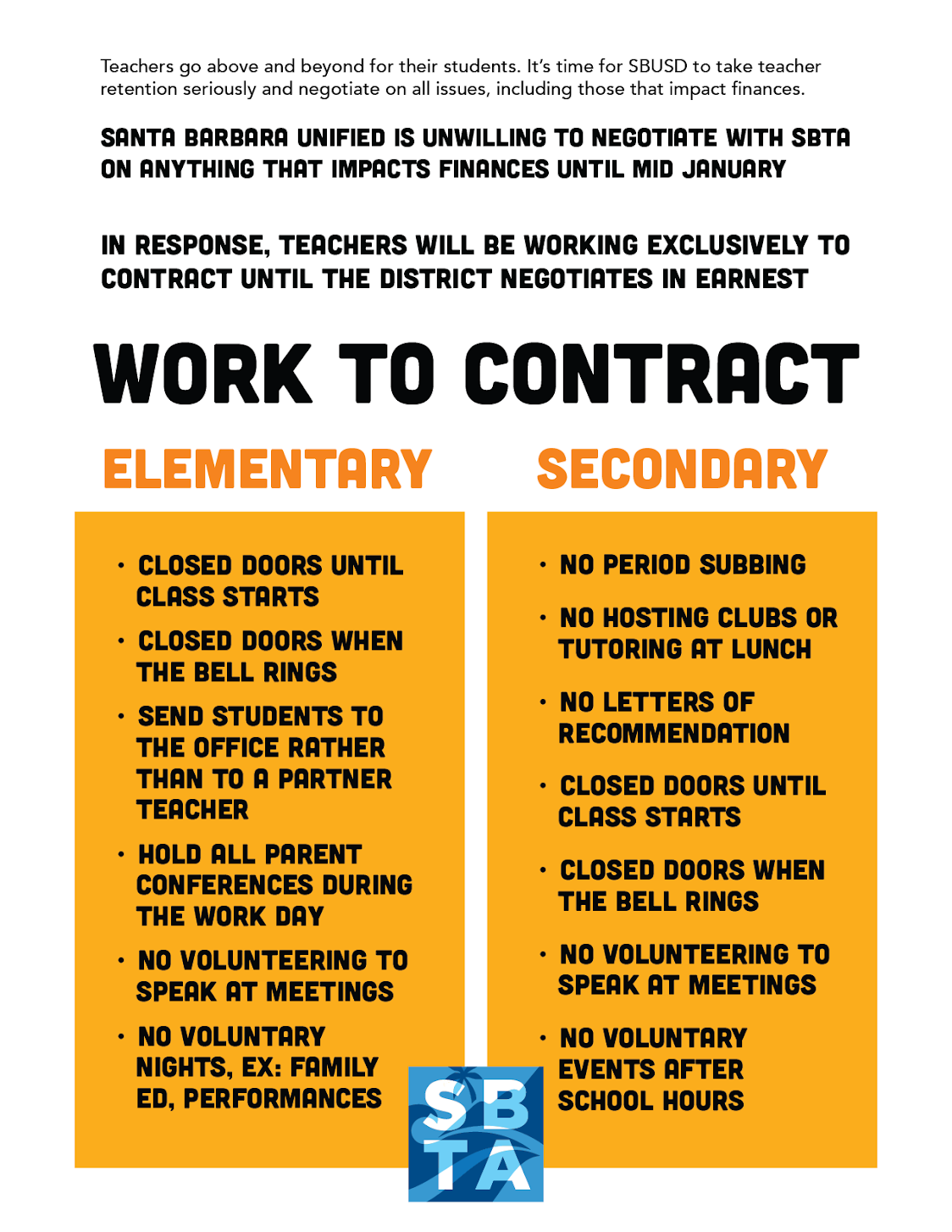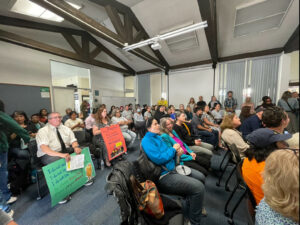Santa Barbara High is facing an impending teacher work to contract event as conflicts between the district and Santa Barbara Teachers Association (SBTA) continue. A work to contract– also known as a work to rule– would mean that teachers would slow down on any volunteer work that is not covered in their salary contracts. This includes advising clubs, writing letters of recommendation, opening their classrooms at lunch time, and many other conditions. The work to contract comes as a response to continued conflicts between SBTA and SBUSD over contract negotiations for teachers. While the work to contract was set to start on Wednesday, November 1, it was pushed back, following the district’s message to students and families on negotiations.
The district sent a ParentSquare message to students and families on negotiations on October 24. The message said, “Last Spring, the District expressed interest in starting negotiations early and is following through on that by starting approximately three to four months earlier than in previous years. The District has proposed to SBTA additional negotiation dates in January, February, and March, knowing that this process could take us into the Spring.
The entire contract is open for negotiations, and compensation and health benefits are the most critical and impactful topics to solve. The district values its employees and stands ready to engage in meaningful negotiations on November 15 of any proposals that are brought forward.” Previously, the district had said that they would not open negotiations for the financial aspects until January of this year. Now, the work to contract is scheduled to come on November 16 if the district doesn’t open meaningful financial negotiations with teachers in the November 15 meeting. SBTA President Hozby Galindo explained the issues, saying, “Last spring during negotiations, it became clear that the administration and school board were not taking the issue of attracting and retaining teachers seriously. They played games at the bargaining table instead of working with us to solve the problem. We need them to take this seriously.”
The message came on the same day that the district applied for a waiver to spend below the state minimum on teacher salaries last school year. As a California school district, SBUSD is required to spend a minimum of 55% of their annual expenditures on teacher salaries. Last year, the district only spent 51% on teacher salaries, a difference of $6.7 million below the state minimum. This required them to apply for a waiver from the California Department of Education, and the district has blamed the ratio on an increase in one time COVID-related expenses. Salaries are just one part of the union’s 21 point platform for teacher’s rights. Some of the other factors up for negotiation are health care, class sizes, and special education caseloads, which all translate to financial impacts on the district’s side. SBUSD has lost over 200 teachers in the last two years out of over 850 non-management employees who work in the district.
Teachers were surveyed before the summer to determine willingness for the work to contract, but the decision was actually made when the district stated that they wouldn’t be starting bargaining about financial issues until January. November 15 is the first day that both teams will be meeting to bargain. If the district is prepared to bargain about salaries and benefits, the work to contract won’t be necessary to gain a response from the district. All teachers are welcome to start the work to contract before the November 16 date, but the organized movement won’t take place until then. Some of the biggest impacts to students will be that teachers will close their doors before and after school as well as during lunch, so club meetings will have to take place outside of the classroom. Ashley Cornelius, bargaining team and executive board member for the union, said, “The last time we had to do something like this was maybe 20 years ago…some of our more experienced teachers who have been here a while found it to be effective. So some teachers had been asking ‘are we going to do it?’ and a lot of the union leadership knew that was something that we had in our back pocket to use as needed.” As Kate Lambert, organizing lead for the union, put it, the end goal of the work to contract would be, “Fair negotiations…There’s things that we want that would be wonderful if we could negotiate on them in a cooperative way rather than antagonistic…it’s going to be a bit of a battle but we would rather have it be a conversation that has a good outcome.” The union is also hoping that the work to contract will garner parent and student support, a necessary catalyst for union response.
Speaking on the impact on students, Cornelius says that she hopes students will realize how much teachers do outside of their contractual duties, but that there’s a potential for students to have to be more efficient with their work, as there won’t be opportunities to do it during lunch or before or after school. “It’s tricky because we don’t want to impact the students, but we also need to make the community and our families aware of how much work teachers are putting in outside of their contract to make the school run and to make the school better,” she said.
While the union wants to reach negotiations before the work to contract is necessary, if these negotiations don’t come in time, they’re hoping that the work to rule will bring about bargaining by putting pressure on the district. They’re preparing people to potentially have the work to contract until January, when the district had originally said they were willing to talk about finances. Cornelius knows that the work to contract will be hard on both teachers and students, saying, “Teachers just love their students and they don’t want their students to be put in the middle of it. They don’t want to be using our students as pawns in this…but we also are looking at the long term health of our district, about what we need to keep teachers so that long term we aren’t burning out teachers and we are keeping them. So we know long term that it will be effective, but it’s hard to say no to things that we know our students value.”
The coming weeks will be important to watch as the possibility of a work to contract looms over Santa Barbara High. As the union issues hang in the balance, the implications for students and teachers will continue to be revealed.
[Image Courtesy of SBTA]






Be First to Comment